Elusive creatures in fossil wood –
Clean-up
in the wake of a
waning obsession
Since about two decades ago, reports on
sightings of oribatid mite coprolites in Carboniferous, Permian, and
Triassic wood appeared and became increasingly popular with time in
some
part of the palaeobotany community although the mites themselves
remained unseen.
Publications by R. Rößler,
including a monograph [1], are a veritable
repository of alleged mite coprolites, as pointed out before (Fossil
Wood News 12).
Neither the absence of mites nor the peculiar
facts that the sizes of
the alleged coprolites always agreed with those of the cells of nearby
tissue, and that often the shapes were angular like the cells [2], gave
rise to suspicion. Local damage to the tissue was interpreted as frass
galleries even if the cavities were so narrow that no mite producing
the
cell-size clots could have
crept there.  Nobody wondered
about how the clots called
coprolites could have got into intact cells, where they are seen more
often than not. (Fossil
Wood News 3,
5)
Nobody wondered
about how the clots called
coprolites could have got into intact cells, where they are seen more
often than not. (Fossil
Wood News 3,
5)
The mite coprolite hypothesis has never been doubted in the scientific
literature, and it proliferated by uncritical adoption. Own efforts
with the aim to spread critical arguments had the effect that some
authors do not speak about mite coprolites any more. Not so R.
Rößler
[3,5]
and Z. Feng
[4,5], who seemed to have had a common interest in keeping up
the coprolite fancy and evading any discussion on the subject. This
resulted in the contributions Fossil
Wood News 4,
5 and a writ by Rößler's
lawyer declaring the mite coprolite hypothesis
the state of science. While
others have quietly dropped the idea, Rößler
and Feng
seem to be resolved to stick to it but they made the concession
to abandon the "oribatid mites"
and replace them by
"unknown
creatures" [3] or "new
detritivores" [5]*. These
are terms thought up in vain since the clots cannot be coprolites,
which meanwhile has been demonstrated with numerous examples (Fossil
Wood News 7).
What is left over from the
subsided oribatid mite coprolite craze is its
debris in the palaeobotany literature. The
professionals who spread it
are not inclined to clean up. The much praised ability of science to
correct itself has got lost in parts of palaeobotany. Hence,
weeding out the errors and misconceptions must be done by
outsiders. A few more examples are presented here.
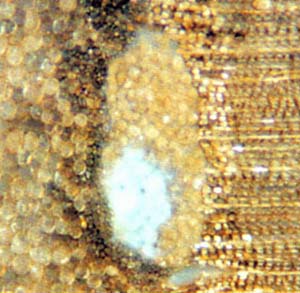
Fig. 1: Detail from [1], Bild 441, described there as a tunnel eaten
into coniferous wood, filled with coprolites.

Fig.2 (right): Coniferous-type wood cells squeezed into an
imperfect honeycomb structure by bloating apparently due to some
expanding matter inside.
Detail from [4], Fig.6E, interpreted as oribatid mite
coprolites there.
Doubts
concerning coprolites in Fig.1 are raised by the observation that the
clots are densely packed and of various sizes and shapes, on the
average slightly bigger than the wood cells on the right and slightly
smaller than the pith cells on the left. Comparison with similar
structures (Fig.2) suggests that they are bloated and slightly
displaced wood cells, filled with some light-coloured matter, as
explained in Fossil
Wood News 5.
 Similar
phenomena are pictured
in [6] and Fossil
Wood News 21,
Fig.7 there.
Similar
phenomena are pictured
in [6] and Fossil
Wood News 21,
Fig.7 there.
Fig.3 (right): Expanded tissue inside a cavity in silicified wood (Fossil
Wood News 14).
Width of the cavity 2mm.
There are more examples of cavity formation in wood in
combination with the bloating of cells (Fig.3).
All that can be said here about the wood damage in Figs.1-3
is that there is some obscure connection with expanding cells but no
connection with tunnel-boring creatures. The obsession of some authors
with alleged
arthropod
traces in fossil wood had apparently misled them to the assumption that
the furrows in the Lower Permian fossil wood in Fig.4 are burrows. As
seen already on the image, the furrows have V-shaped cross-sections,
often with a thin line along the bottom. Such furrows cannot be
burrows.
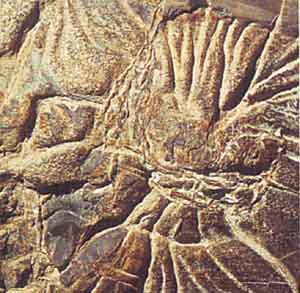
Fig.4: Alleged arthropod burrows on the surface of Permian
wood,
after Rößler,
detail of Bild 442 in [1], there with wrong scale. Width of Fig.4 as
measured on the sample: 14cm. The furrows must be shrinkage cracks
formed during silicification, later widened by spalling
fracture
on the crack edges: no burrows.
(New picture and desctiption: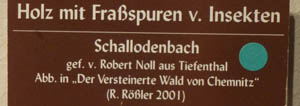 Fossil
Wood News 29.)
Fossil
Wood News 29.)
Label to the sample of Fig.4,
Paläontologisches Museum Nierstein
According to the scale 4:1 in [1] the size
of Fig.4 would be 1cm,
which is highly questionable. A check at the Paläontologisches
Museum Nierstein gave 14cm. Close
inspection of the sample confirmed the conclusions already derived from
the image: The wide furrows developed from narrow shrinkage cracks.
Repeated impact of river pebbles caused spalling fracture at the crack
edges, which created cross-sections with V-shape in the depth and
rounded edges above. The original narrow crack, which may be filled
owing to later silicification, is seen within some furrows as a thin
dark
line along the bottom, eventually with a tiny
ridge left over from the broken away narrow crack fill. Needless
to
say that a boring creature could never make grooves of such peculiar
shape.
Shrinkage crack formation during silicification
is a common phenomenon. There are conspicuous examples in Permian wood
from the Döhlen Basin.
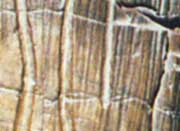 Fig.4
has
been turned here such that the light comes from above left which makes
a better 3D-impression.
By the way, Bild 442
in [4] is the mirror image of the object, and so is Fig.4. This
information may be useful for comparison with the sample.
Fig.4
has
been turned here such that the light comes from above left which makes
a better 3D-impression.
By the way, Bild 442
in [4] is the mirror image of the object, and so is Fig.4. This
information may be useful for comparison with the sample.
Fig.5 (right): Galleries with U-shaped cross-sections without crack
along
the bottom, and
cracks on the surface of a fossil tree trunk
from Chemnitz. Detail of Fig.5 in [7]. Width of the picture 7.5cm.
Burrows
and galleries below the bark would be U-shaped and without a narrow
crack along the
bottom, like those shown in Fig.5
for comparison.
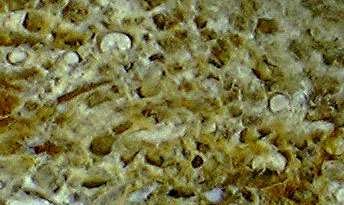
As a big surprise after so much vain talk about mite coprolites without
mites we may have fossil mites without coprolites now.
Gert
Müller
seems to have got the elusive mites in their
burrows in plant tissue preserved in chert
(Fig.6) [8]. As expected, none of the popular "coprolites" are seen
there.
Fig.6:
Juvenile arthropods in burrows in degraded tree fern tissue in Lower
Permian chert, Freital, Döhlen
basin,
Saxony.
Width of the picture about 3mm. Sample and photograph by Gert
Müller.
Amendment 2015:
After having avoided the disputed term
"oribatid mite coprolites" for some time, R. Rößler has
made use of it again recently [9,10] despite of plain evidence proving
it ill-conceived: see Fossil
Wood News 23,
24.
H.-J.
Weiss
2012, updated 2013, 2014, 2015, 2019
[1] R. Rößler:
Der versteinerte Wald von Chemnitz. Museum f. Naturkunde Chemnitz 2001
[2] H.-J. Weiss:
Milbenfraß und Milbenkot, 6th Chert Workshop, Naturkunde Museum
Chemnitz, 2007.
[3] M. Barthel,
M.
Krings, R. Rößler: Die schwarzen Psaronien von Manebach,
ihre Epiphyten,
Parasiten und Pilze.
Semana 25(2010), 41-60. (
recently re-named, former name: Veröff.
Naturhist. Mus. Schleusingen)
[4] Zhuo
Feng,
Jun Wang, Lu-Yun Liu: First report of oribatid mite
(arthropod) borings and coprolites in Permian woods from ... northern
China.
Palaeogeography,
Palaeoclimatology, Palaeoecology 288(2010), 54-61.
[5] Zhuo Feng,
Jun Wang, Lu-Yun Liu, Ronny Rößler: A novel coniferous
tree trunk with septate pith ...
Int. J. Plant Sci. 173(2012),
835-48.
[6] H.-J. Weiss:
Beobachtungen an Kieselhölzern des Kyffhäuser-Gebirges.
Veröff. Mus.
Naturkunde Chemnitz 21(1998), 37-48.
[7] R. Rößler,
G. Fiedler:
Fraßspuren an permischen Gymnospermen-Kieselhölzern ...
Veröff. Mus. Naturkunde
Chemnitz 19(1996), 27-34.
[8] G. Müller:
private communication.
[9] R.
Rößler, R. Kretzschmar, Z. Feng, R. Noll: Fraßgalerien von
Mikroarthropoden in Konifernhölzern des frühen Perms von Crock,
Thüringen.
Veröff. Mus.
Naturkunde Chemnitz 37(2014), 55-66.
[10] Zhuo
Feng,
J.W. Schneider, C.C.
Labandeira, R. Kretzschmar, R.
Rößler: A specialized feeding habit of Early
Permian oribatid mites.
Palaeogeography,
Palaeoclimatology, Palaeoecology 417(2015), 121-124.
|

|
 16 16 |

 16
16 Nobody wondered
about how the clots called
coprolites could have got into intact cells, where they are seen more
often than not. (Fossil
Wood News 3,
5)
Nobody wondered
about how the clots called
coprolites could have got into intact cells, where they are seen more
often than not. (Fossil
Wood News 3,
5)


 Similar
phenomena are pictured
in [6] and Fossil
Wood News 21,
Fig.7 there.
Similar
phenomena are pictured
in [6] and Fossil
Wood News 21,
Fig.7 there.
 Fossil
Wood News 29.)
Fossil
Wood News 29.) Fig.4
has
been turned here such that the light comes from above left which makes
a better 3D-impression.
By the way, Bild 442
in [4] is the mirror image of the object, and so is Fig.4. This
information may be useful for comparison with the sample.
Fig.4
has
been turned here such that the light comes from above left which makes
a better 3D-impression.
By the way, Bild 442
in [4] is the mirror image of the object, and so is Fig.4. This
information may be useful for comparison with the sample. 

 16
16